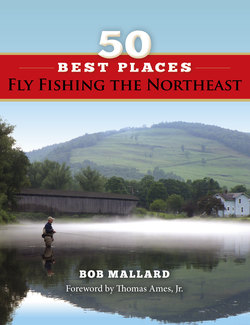Читать книгу 50 Best Places Fly Fishing the Northeast - Bob Mallard - Страница 55
На сайте Литреса книга снята с продажи.
Оглавление9 . Kennebago River
Location: Northwestern Maine, about a 3-hour ride from Portland and Bangor; a 3-hour ride from Manchester, New Hampshire; and a 4-hour ride from Boston, Massachusetts. Full-service airports are available in all four cities.
The Rangeley Lakes Region is rich in history and lore, and the Kennebago River is part of the reason. In the 1860s, word began to spread about the giant brook trout that inhabited the waters of this wild and remote corner of New England. In 1868, the Oquossoc Anglers Association was founded at the mouth of the Kennebago River, and fly-fishing exploration of the river began. Ed Grant founded Grant’s Kennebago Camps on Kennebago Lake in 1906. The camps are still in operation today.
Kennebago is the name of a tribe of Native Americans who inhabited the area around Kennebago Lake. It translates to “people of the land of sweet flowing waters.” They were the first to recognize the commercial potential of the area, guiding sportsmen from Boston and New York.
The Kennebago begins at Big Island Pond along the Maine-Quebec border. The river is roughly 25 miles long. It is a diverse mix of slow, meandering stretches, short riffles, and pocketwater. Several miles below Big Island Pond, the river is interrupted by Long Pond. From there it flows roughly 8 miles before entering Little Kennebago Lake. A couple of miles after exiting Little Kennebago, the river is joined by the outlet of Kennebago Lake—the largest fly-fishing- only lake in Maine. From here
the Kennebago flows unbroken for roughly 8 miles before terminating at Mooselookmeguntic Lake. Both Kennebago and Little Kennebago Lakes offer outstanding fishing for brook trout and the occasional landlocked salmon. Kennebago Lake is gated against public access. Little Kennebago Lake is accessible to the general public. The latter is restricted to nonmotorized boats only.
The Kennebago is divided into four sections. The first, and least fished, is between Big Island Pond and Little
Kennebago Lake. This section has a resident population of brook trout. The second is from Little Kennebago Lake to Kennebago Lake. Most of the fish here come from the two lakes. The third section is from Kennebago Lake to the bridge on Kennebago River Road. Fish from Mooselookmeguntic Lake reach the lower end of this section. There are also resident brook trout. The last section is from the bridge to Mooselookmeguntic Lake—including fabled Steep Bank Pool. Large brook trout move up into the river from the lake in late May and again in early fall. Landlocked salmon move in soon after the brook trout.
There is good public access to the Kennebago between Steep Bank Pool and Mooselookmeguntic Lake. A gate just above Steep Bank prevents motorized traffic. You can,
Fall fishing on middle river. Diana Mallard
how ever, fish above Steep Bank if you walk, or have permission to go beyond the gate, usually associated with stays at one of the sporting camps. From Steep Bank to Kennebago Lake, the river is mostly riffles, fast water, pocketwater, and pools. Many fly fishers do use the road for walk-in access. This section provides a level of solitude not found on the easy-to-ac- cess water downstream of the gate. Fishing can be quite good in this section—possibly the best on the river.
